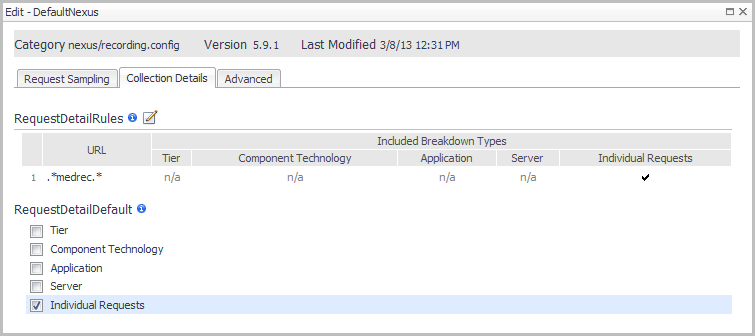Configuring Response Time Breakdown settings
In order to use the Response Time Breakdown tab and Explorer dashboard, and the Error Explorer dashboard, you must configure the integration between Foglight for Application Operations and either Foglight for Java EE Technologies or Foglight for Microsoft .NET, as described in: Configuring request breakdowns.
After you have configured request tracing, you may also want to review Configuring URL transformations.
|
TIP: If you are using FxV as your real user data source, you must also associate hit filter mappings with Java™ requests and real user data, as described in Associating FxV hitfFilter mappings for response time breakdowns. |
Configuring request breakdowns
In order for the request information to be traced correctly, you must configure the Individual Request Breakdowns option for the Nexus™ that is coordinating the .NET® data. For detailed information about the Nexus and for instructions for configuring recording settings, see the Foglight for Application Servers Administration and Configuration Guide.
|
1 |
|
2 |
On the Application Servers Administration dashboard, click Nexus Administration. |
|
3 |
On the Nexus Administration page, click the Recording Settings tab. |
|
4 |
On the Recording Settings view, click the name of the Nexus™ profile that you want to configure, and select Edit from the menu that opens. |
|
5 |
Click the Collection Details tab. |
|
6 |
|
8 |
Select the Regex check box. |
|
9 |
Click the URL box and type the URL for which you want to enable individual requests. |
|
10 |
Select the Individual check box. |
|
11 |
Click OK. |
|
12 |
Select the RequestDetailDefault > Individual Requests check box. |
|
13 |
Click Save. |
If you are using Foglight for Java EE Technologies version 5.8.2 or 5.8.3, you must configure request tracing breakdowns through the Java Agent recording.config property file. For detailed information about configuring request tracing, see the Foglight for Java EE Technologies Installation Guide included with the cartridge.
|
1 |
On the navigation panel, click Administration > Agents > Agent Properties. |
|
2 |
In the Namespace > Type column, expand the JavaEE module (click the + sign). |
|
3 |
Select recording.config. |
|
4 |
|
5 |
|
6 |
Click Save. |
Configuring URL transformations
Foglight for Java EE Technologies and Foglight for Microsoft .NET (version 5.9.x and later) provide the ability to transform Java™ or .NET® transaction URLs for use with the Foglight APM Transactions dashboard. The APM URL Transformation options control the following:
By default, request URLs are shortened to the third ‘/’.
For more information, see the topics “Setting rules for transforming URLs” and “Configuring APM URL transformation” in the Foglight for Application Servers Administration and Configuration Guide or help. This guide also contains detailed information about how URL transformations are configured and performed in general.
Additional configuration options
There are additional configuration options for exploring response time breakdowns that may be useful in some instances. For example, if your dependency path view contains a datasource that needs to be mapped to a specific component, review the topic Mapping datasources. If you are associating FxV hit filter mappings to a transaction that contains a proxy object, review the topic Assigning proxy objects.

